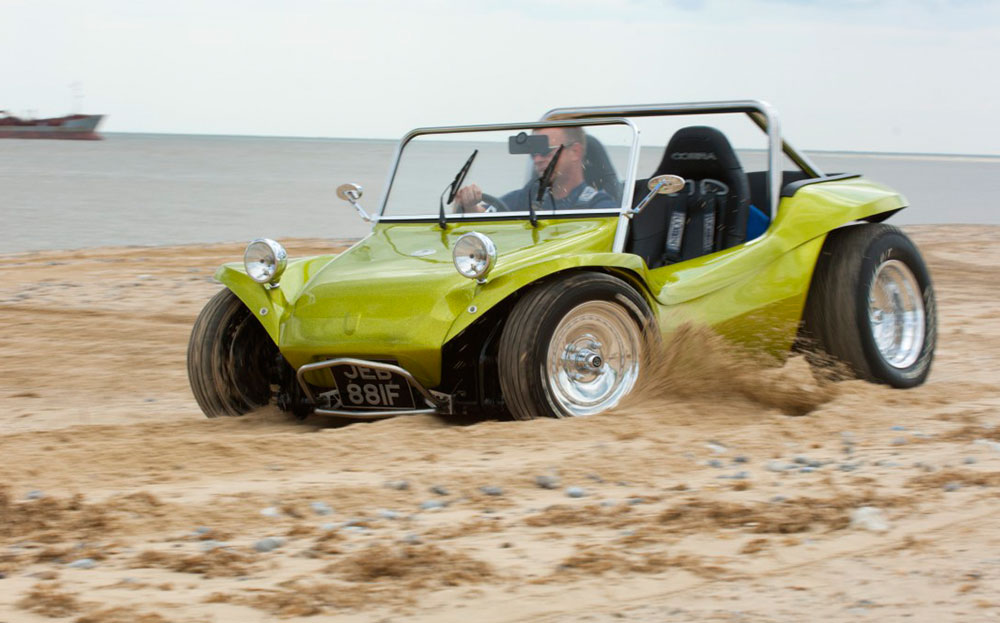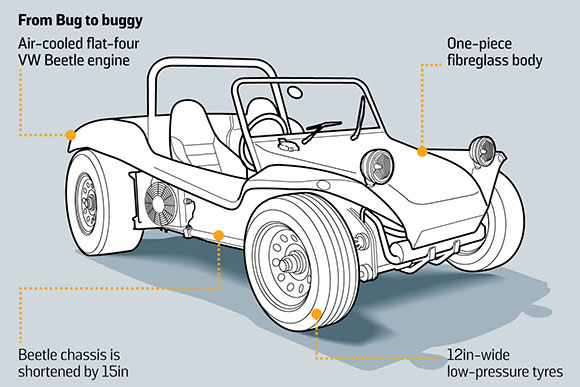The big beach buggy revival
California dreamin’ is back as Britain catches the buggy bug

WE WERE young, and we had no taste. We wore loon pants with grandad vests and kinky boots with three-inch soles, and we drove psychedelic plastic bathtubs on wheels that handled like badly loaded wheelbarrows — but who cared as long as you were cool?
Click to read more REVIEWS or search NEW or USED cars for sale on driving.co.uk
Most relics from the 1970s are buried with stakes through their hearts, but the beach buggy refuses to die, and there are signs that the fickle finger of fashion is once again pointing in its general direction. Go to the coast and increasingly you will see them pootling around the sandy lanes, a child’s fishing net poking out of the top. The new Man from U.N.C.L.E. film features a beach-buggy-inspired vehicle and UK sales are on the rise. OK, it’s still early days and numbers will reach — wait for it — three figures this year, but bear in mind that they had fallen to an estimated eight after the recession hit.
Estimation is necessary — there are no official sales figures. The numbers come from the small companies across the country that still make them. Places such as Flatlands Engineering in King’s Lynn, Norfolk. Here the waiting time for a beach buggy has gone up to six months, and the staff (both of them) are working hard most days to meet demand.
According to Mark Dryden, the company owner, the beach buggy used to be a cheap way of getting onto the road in something cool, but today’s buyers are lured by the ghosts of a beach-bum lifestyle that perhaps never existed. “It’s a real throwback to the Sixties and Seventies and it reeks of carefree fun and excitement in simpler times. There’s a big retro market in cars and the buggy was absolutely unique — there was nothing remotely like it,” he says.
Steve McQueen drove one in The Thomas Crown Affair, the baddie ran down the poor countess in a beach buggy in the Bond film For Your Eyes Only and no Elvis film would have been complete without one
In Devon, JAS Speed Kits says it has sold a bespoke buggy to the president of East Timor, and two to a bakery for promotion work, while in Rutland, East Coast Buggies — fittingly, nowhere near the east coast — might make 20 bodies this year. In beach buggy land, that means the business is on fire. John Davies, of JAS, says: “Most of my customers are of a certain age, and they missed out on beach buggies first time round. Maybe they didn’t have the money, or maybe they had young families in the Seventies, and now they’re recapturing what they missed.”
Beach buggies arrived in Britain from California in the Sixties and became a common sight in the next few years. Steve McQueen drove one in The Thomas Crown Affair, the baddie ran down the poor countess in a beach buggy in the Bond film For Your Eyes Only and no Elvis film would have been complete without one.
The concept was invented in 1964 by a California surfer called Bruce Meyers, who took a Beetle, discarded the bodywork, sawed about 15in out of the middle of the chassis and welded it back together, and then bolted on a fibreglass body in a flowing shape that remains the industry standard today. Wheelarches were flared to take wide 12in treadless racing tyres, which were run at low pressure — perhaps 14psi at the back and 12psi at the front, partly to cope with soft sand and partly to cope with suspension that was dreadful. The air-cooled rear-mounted engine didn’t have to be removed from the chassis to make the conversion, and the steering too remained in situ.

Specialists sprang up making the one-piece fibreglass bodies. Colour is supremely important to the aesthetic: shocking pink, fizzy orange or flaky metallic. Bells and whistles such as a windscreen, roll bars, lights and so forth could be added. Meyers patented the design but lost an infringement suit when a court ruled it was too generic to qualify, and since then it’s been a free-for-all. But nobody’s done it better than Meyers did, and Flatlands Engineering makes near replicas of his original by agreement with Meyers.
As a buyer you can have as much or as little work done as you feel capable of handling. East Coast Buggies will sell you the fibreglass bodywork and little else for between £1,200 and £2,000, depending on paint choices, and you do the rest. Flatlands Engineering will source the dead Beetle and sell you the finished article for £14,500.
If you want to use the car on the road you will need an individual vehicle approval certificate (IVA), issued by the DVSA. Most buggies should comply, although Flatlands charges an additional £2,500 for an IVA-compliant buggy, which comes with lights, seatbelts and other basic paraphernalia. If you just want to drive your buggy on private land (a local farmer’s field, for instance) there is no need for an IVA. And if the source Beetle was made before 1973 they don’t attract road tax.
“Most beach buggies never leave the tarmac. . . People tend to stay out of the rough stuff, and they certainly won’t go near the beach”
The driving experience is as retro as the look — handling will take you right back to the Seventies. And in terms of weather protection they are truly comfortable on only about three days a year, when Britain experiences California-style sunshine.
But none of this matters when you’re at the wheel, attracting stares from passers-by and weaving between families trapped in sweaty hatchbacks. In fact, the only thing that could kill off the nascent revival isn’t changing fashions, but a lack of supply. Even though 20m VW Beetles were built, none has been made in Europe for more than 35 years. It means that donor vehicles are getting harder and harder to find, and more expensive.
And don’t expect to see one down on the sand, as we did in the 1970s, either. “Most beach buggies never leave the tarmac,” says Dryden from Flatlands Engineering. “People tend to stay out of the rough stuff, and they certainly won’t go near the beach. An owner who’s paid £15,000 for a buggy certainly doesn’t want it immersed in salt water.”
Banned sand
Most of Britain’s beaches are owned by councils, landowners, the Crown Estate or the National Trust — and vehicles are mostly banned.
One exception is Black Rock Sands, near Porthmadog, Gwynedd. You won’t be recreating the sand-churning, powersliding shots beloved of promotional car videos, though. There’s a 10mph speed limit and the Road Traffic Act applies, as the beach is a public space.
Motorists may also park on the public section of Pendine Sands in Carmarthenshire, where land-speed records were set in the 1920s. The seven-mile coastline can still be hired for film shoots and speed attempts at evenings and weekends, but you wouldn’t want to drive on it at any other time: most of it is owned by the MoD and used for weapons testing.
There’s a myth that cars are allowed to drive on the foreshore of beaches — the area of sand between the high and low tide marks. Not so, says the Crown Estate.
Click to read more REVIEWS or search NEW or USED cars for sale on driving.co.uk




